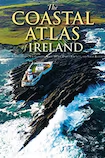
The Coastal Atlas of Ireland is an enormous book of 900 pages and 5kg in weight, which requires a coastal shelf to hold it. Packed with information, maps, case studies and photographs, it is the summary of several lifetimes of knowledge shared between its five editors, and will become the standard work of reference for the geographic and scientific understanding of Irish coastlines for generations to come.
As a book to read, it has its challenges. The atlas is arranged in six sections, each of which addresses a broad subject field, such as Natural Coastal Environments or Resources, Communication and Industry. Some of these lend themselves to curiosity more than others. And some of the early prose summons the sea like a lead weight, the dry jargon of measurement and identification buoyed only by the timescales the atlas works in, the pre-glacial sediments visible in the cliffs west of Kinsale a vision of earth and sea in dimensions vast and magical.
Walking in the rain, years ago, the late author and cartographer Tim Robinson thought about the challenges of scale and volume in mapping any coastline as he scrambled across the razor headlands of Árainn Mhór. Trained as a mathematician and visual artist, he realised that the closer you look at a coastline, the more you see – the wash of the bladderwrack on land a sign shaped by deep sea, tide and storm.
Robinson thought of writing this coast as a fractal practice, the form of his description contingent, associative and immersed in diverse forms of knowledge, encoded in language and the littoral. His map of the islands is included in the atlas, his philosophy less so.
This elision points to the one thing the atlas does not do, which is to integrate its very wide range of perspectives into descriptive practices that help us see the coast as the dynamic site of multiple forces, imaginary, inherited, measurable and real. There are episodes of art and literature in the atlas, which is framed by poems from Pádraig Ó Tuama and Theo Dorgan, but fragmentarily and sometimes strangely out of kilter, as when 19th-century historical paintings are used to illustrate episodes of Viking or Norman history. It is as if these visualisations are not products of their own separate places and times.
The duller traditionalists in literature can be equally resistant to the combined thinking about form and place that coastal work invites, insisting on a fictional clarity that is a mole against a liquid world whose historical patterns are shifting with warming seas and ocean acidification. But the Coastal Atlas blooms where it opens out to diffuse perspectives.
The case studies that punctuate the book are uniformly fascinating and often excellent. Hiram Morgan’s synopsis of the Spanish Armada is a brilliantly compact history of European maritime misadventure. Regina Sexton’s tour of the food history of the sea is resonant and contemporary, while Connie Kelleher’s brief history of piracy and smuggling is wonderful.
The great quality of the Coastal Atlas is this aspect of surprise, which given the weight of the book is something like the discovery of a skittery crab under a rock pool stone. There is the tattoo of old Norse in place names such as Dursey, Haulbowline and Smerwick, and the confirmation of Malin Head as Ireland’s windiest place. Then there is the Lisbon Tsunami of 1755, which shoved marine sands ashore around Rosscarberry, and the hurricane Night of the Big Wind in 1839, still remembered in Joyce’s Ulysses.
The quaternary geology of Clew Bay suggests something of the hauntedness that the writer Kevin Barry has found in this submerged valley, and there are important accounts of naturalists, scientists and artists such as George Du Noyer, Maud Delap, Ellen Hutchins, and, in our time, the pioneering Matt Murphy.
The poetry of the Coastal Atlas is in the places, people and other life forms with whom we share the water world, the dark coastal reefs in the deep sea off western Ireland a reminder of the richness of our maritime inheritance, and of its global aspect. The complexities of this interconnectedness register in the difficulties conservationists face in helping migratory birds who fly vast distances to winter in wetlands such as Inch, in Donegal, and the Lady’s Island Lakes, in Wexford, the refuge of roseate terns.
The Sanderling in looping transit from Siberia have no interest in our borders, their atlas a pulse of magnetic attraction, lodged in the old brain and felt in the thrum of the wing muscles. The richness of these birds, their lives and variety, of Shelducks, Dunlins and Black-tailed Godwits, is one with the sea and skyscapes the atlas draws for the reader, the sandy ridges of the intertidal zone described memorably as “the natural artwork of the sea”.
The atlas is a great collective achievement. It will be a point of departure for generations of readers, writers, walkers and waders to look again at the beaches, cliffs, forelands and spits that shape the calligraphy of island life. It is dense and sometimes puzzling, as when the tragic account of the sinking of the Lusitania precedes a guide to coastal walks, but it is endlessly interesting, and the collective representation of its editors’ immense scholarship.
It is also testament to the endless resourcefulness of human populations across deep time, from the Mesolithic wanderers whose lost communities circled the now submerged shorelines of an Ireland so remote it seems another island, to the parishioners of Carrigaholt, who built the Little Ark of Kilbaha to celebrate Mass on the foreshore, where the landlord’s edicts against Catholicism had no hold.
Immediately part of our shared library of national reference, The Coastal Atlas of Ireland is an invitation to think, like poet Moya Cannon, “sea-deep, time-deep”, of places water wears thin as “a fish’s fin”.
Nicholas Allen’s latest work is Ireland, Literature, and the Coast: Seatangled










